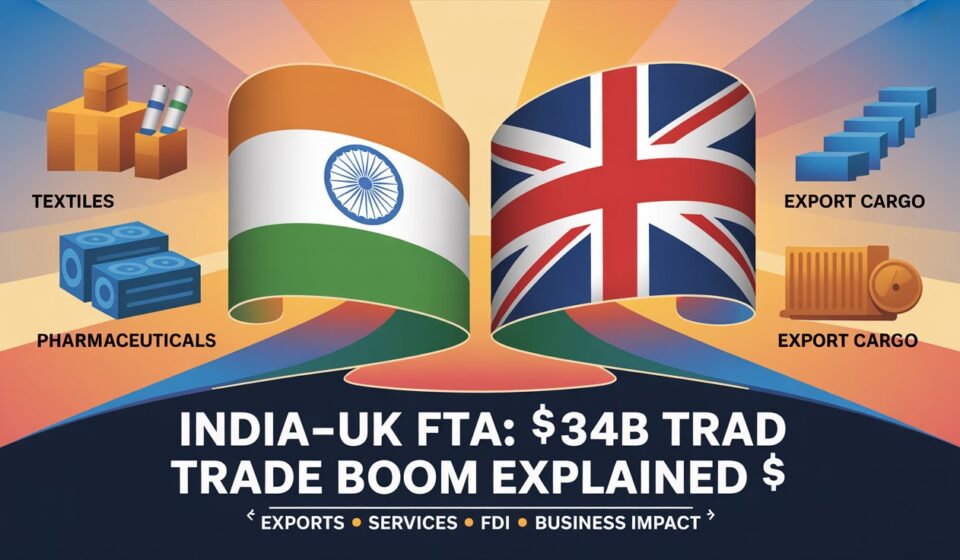Why This Trade Deal Matters Now
On 24 July 2025, Indian Prime Minister Narendra Modi and UK Prime Minister Keir Starmer signed the landmark India – UK Free Trade Agreement (FTA) – a pact expected to boost bilateral trade by £25.5 billion (US $34 billion) annually by 2040 and targets US $120 billion trade by 2030.
This deal – widely seen as the UK’s most consequential since Brexit—includes sweeping tariff cuts, services access, procurement opportunities, and FDI pathways for both nations.
Table Of Content
- Why This Trade Deal Matters Now
- Key Provisions & Sectoral Impact
- 1. Duty-Free Export Access for India
- 2. Wide-Ranging Services & Financial Sector Access
- 3. Government Procurement Access
- 4. FDI Inflows & Strategic Collaboration
- Sector-Wise Breakdown: Who Wins & How
- Emerging Risks & Challenges
- FAQs
- Q1: Which Indian sectors benefit most from the India–UK FTA?
- Q2: What are the services and mobility benefits for Indian professionals?
- Q3: What procurement access does the UK’s FTA with India offer?
- Q4: What is the projected impact on trade and investment?
- 5-Step Action Plan for Indian Businesses & Finance Professionals
- Final Takeaway
Key Provisions & Sectoral Impact
1. Duty-Free Export Access for India
- 99% of Indian exports to the UK – including textiles, gems, marine products, pharma, and processed foods – will enjoy zero duty.
- UK tariffs on Indian auto parts, machinery, and electronics will fall sharply to an average of 3% from ~15%; Scotch whisky’s tariff halves immediately and falls to 40% in 10 years.
- Certain electronics and auto imports may enter India with quotas (~10%) at 10% duty – up from over 100% currently.
2. Wide-Ranging Services & Financial Sector Access
- UK financial and professional services firms are guaranteed equal footing in India under the FTA. India cannot limit investment or cap British firms’ operations – marking a first-ever financial services clause in an Indian FTA.
- Indian professionals – including IT, yoga instructors, chefs, and musicians – can enter the UK as contractual service providers or business visitors, exempt from British social security contributions for up to three years, affecting around 75,000 workers and saving ~₹40 billion annually.
3. Government Procurement Access
- UK firms gain access to India’s federal government procurement tenders above ₹2 billion (~£38 billion annually across 40,000 tenders), unlocking major opportunities in infrastructure, clean energy, healthcare, and transport.
4. FDI Inflows & Strategic Collaboration
- The agreement paves the way for £6 billion in new investments in aerospace, fintech, clean energy, healthcare, and tech services. UK GDP projected to rise by £4.8 billion annually by 2040, while India’s export-led growth accelerates.
Sector-Wise Breakdown: Who Wins & How
| Sector | Impact & Opportunity in UK / India |
|---|---|
| Textiles & Apparel | Tiruppur, Surat, Ludhiana clusters projected to benefit with exports rising significantly thanks to zero duty access. |
| Gems, Jewellery & Leather | Indian MSMEs (e.g., Vardhman, Welspun, Arvind) gain better access to UK luxury markets. |
| Engineering & Auto | Auto component exports benefit from tariff elimination; Indian vehicles gain quota-based UK access. |
| Pharma & Chemicals | Duty-free access improves competitiveness in British markets; chemicals exports poised to scale by 2029–30. |
| Services & IT | Indian IT, legal, and consultancy firms tap new UK contracts; UK firms enter Indian markets more freely. |
| Public Procurement | UK contractors can bid for major federal projects in India. UK chambers predict widespread SME take-up. |
Emerging Risks & Challenges
- Carbon Border Adjustment Mechanism (CBAM): Affects sectors like steel, aluminium & fertilisers -Indian exporters may incur costs from 2027 unless renegotiated. India is exploring countermeasures if UK enforces CBAM aggressively.
- Bilateral Investment Treaty (BIT): Final investment treaty remains pending. Disagreements on sunset clauses and tax dispute resolution may slow UK FDI flow.
- MSME Preparedness: Over 60% of Indian MSMEs lack clarity on Rules of Origin and RoO compliance. Certification burdens (e.g. sustainability standards) may delay benefits.
FAQs
Q1: Which Indian sectors benefit most from the India–UK FTA?
A: Sectors like textiles, apparel, gems & jewellery, engineering goods, auto parts, pharma, marine and marine products gain zero-duty access to the UK, likely boosting exports by 20–45% in key clusters.
Q2: What are the services and mobility benefits for Indian professionals?
A: Indian professionals in 36 UK sectors gain temporary entry, exemption from national insurance for three years, and can legally work without setting up new offices.
Q3: What procurement access does the UK’s FTA with India offer?
A: UK companies can bid for India’s non-sensitive federal government tenders over ₹2 billion (~£38 billion annually across ~40,000 tenders).
Q4: What is the projected impact on trade and investment?
A: Annual bilateral trade could increase by £25.5 billion, UK GDP may grow by £4.8 billion per year by 2040, and fresh £6 billion in UK investments are expected in India’s key strategic sectors.
5-Step Action Plan for Indian Businesses & Finance Professionals
- Map your export eligibility now — confirm Rules of Origin (RoO) compliance for duty-free shipment.
- Claim social security exemptions — register contractual service providers per FTA guidelines to save employer costs.
- Target UK procurement bids — identify projects in sectors like rail, energy, and healthcare valued over ₹2B.
- Update contracts & legal frameworks — ensure that financial service agreements meet equal treatment clauses.
- Monitor CBAM and BIT updates — proactively assess carbon duties and investment protections to avoid surprises.
Bright, modern, business-news style—ideal for Discover.
Final Takeaway
The India–UK FTA is more than tariff elimination—it’s a strategic economic blueprint unlocking export scale, professional mobility, services liberalization, and FDI growth. For exporters, fintech firms, MSMEs, and legal/finance professionals, preparation and timely action are the keys to gaining first mover advantage.




